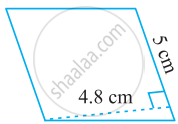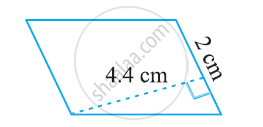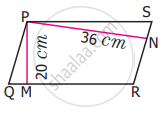Advertisements
Advertisements
Question
If the sides of a parallelogram are increased to twice its original lengths, how much will the perimeter of the new parallelogram?
Options
1.5 times
2 times
3 times
4 times
Solution
2 times
Explanation:
Let the length and breadth of the parallelogram be l and b, respectively.
Then, perimeter = 2(1 + b) ......[∵ Perimeter of parallelogram = 2 × (length + breadth)]
If both sides are increased twice, then new length and breadth will be 21 and 2b, respectively.
Now, new perimeter = 2(21 + 2b) = 2 × 2(l + b) = 2 times of original perimeter.
Hence, the perimeter of parallelogram will be increased 2 times.
APPEARS IN
RELATED QUESTIONS
Find the area of the following parallelogram:

Find the area of the following parallelogram:

Find the missing value:
| Base | Height | Area of parallelogram |
| 20 cm | ______ | 246 cm2 |
A parallelogram has sides of 20 cm and 30 cm. If the distance between its shorter sides is 15 cm; find the distance between the longer sides.
What happens to the area of the parallelogram if the base is increased 2 times and the height is halved?
In a parallelogram the base is three times its height. If the height is 8 cm then the area is
A square and a parallelogram have the same area. If the side of the square is 48 m and the height of the parallelogram is 18 m. Find the length of the base of the parallelogram
The height of the parallelogram is one-fourth of its base. If the area of the parallelogram is 676 sq.cm, find the height and the base
In a parallelogram PQRS (See the diagram) PM and PN are the heights corresponding to the sides QR and RS respectively. If the area of the parallelogram is 900 sq.cm and the length of PM and PN are 20 cm and 36 cm respectively, find the length of the sides QR and SR
Altitudes MN and MO of parallelogram MGHK are 8 cm and 4 cm long respectively in the below figure. One side GH is 6 cm long. Find the perimeter of MGHK.

